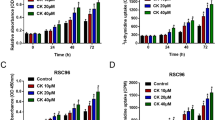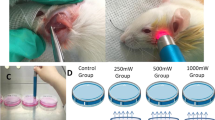Abstract
The facial nerve is one of the vulnerable nerves in otolaryngology. Repair and recovery of facial nerve injury have a high priority in clinical practice. The proliferation and migration of Schwann cells are considered of great significance in the process of nerve injury repair. Danhong injection (DHI), as a common drug for cardiovascular and cerebrovascular diseases, has been fully certified in neuroprotection research, but its role in facial nerve injury is still not clear. Our study found that DHI can promote the proliferation and migration of RSC96 cells, a Schwann cell line, and this effect is related to the activation of the PI3K/AKT pathway. LY294002, an inhibitor of PI3K, inhibits the proliferation and migration of RSC96 cells. Further studies have found that DHI can also promote the expression of CXCL12 and GDNF at gene and protein levels, and CXCL12 is, while GDNF is not, PI3K/AKT pathway-dependent. Animal experiments also confirmed that DHI could promote CXCL12 and GDNF expression and promote facial nerve function recovery and myelin regeneration. In conclusion, our in vitro and in vivo experiments demonstrated that DHI could promote the proliferation and migration of Schwann cells through the PI3K/AKT pathway and increase the expression of CXCL12 and GDNF to promote facial nerve function repair.









Similar content being viewed by others
Data Availability
The data presented in this study are available on request from the corresponding author.
References
Vogelnik K, Matos A (2017) Facial nerve palsy secondary to Epstein-Barr virus infection of the middle ear in pediatric population may be more common than we think. Wien Klin Wochenschr 129:844–847
Hernandez-Trejo AF, Cuellar-Calderon KP, Treviño-Gonzalez JL, Yamamoto-Ramos M, Campos-Coy MA, Quiroga-Garza A, Guzman-Avilan K, Elizondo-Riojas G, Elizondo-Omaña RE, Guzman-Lopez S (2020) Prevalence of facial canal dehiscence and other bone defects by computed tomography. Eur Arch Otorhinolaryngol 277(10):2681–2686
Ishii LE, Nellis JC, Boahene KD, Byrne P, Ishii M (2018) The importance and psychology of facial expression. Otolaryngol Clin N Am 51:1011–1017
Jessen KR, Mirsky R (2016) The repair Schwann cell and its function in regenerating nerves. J Physiol 594:3521–3531
Wood MD, Mackinnon SE (2015) Pathways regulating modality-specific axonal regeneration in peripheral nerve. Exp Neurol 265:171–175
Boyd JG, Gordon T (2003) Neurotrophic factors and their receptors in axonal regeneration and functional recovery after peripheral nerve injury. Mol Neurobiol 27:277–324
Rotshenker S (2011) Wallerian degeneration: the innate-immune response to traumatic nerve injury. J Neuroinflamm 8:109
Cattin AL, Burden JJ, Van Emmenis L, Mackenzie FE, Hoving JJ, Garcia Calavia N, Guo Y, McLaughlin M, Rosenberg LH, Quereda V, Jamecna D, Napoli I, Parrinello S, Enver T, Ruhrberg C, Lloyd AC (2015) Macrophage-Induced blood vessels guide Schwann cell-mediated regeneration of peripheral nerves. Cell 162:1127–1139
Jessen KR, Mirsky R (2019) The success and failure of the Schwann cell response to nerve injury. Front Cell Neurosci 13:33
Gomez-Sanchez JA, Carty L, Iruarrizaga-Lejarreta M, Palomo-Irigoyen M, Varela-Rey M, Griffith M, Hantke J, Macias-Camara N, Azkargorta M, Aurrekoetxea I, De Juan VG, Jefferies HB, Aspichueta P, Elortza F, Aransay AM, Martínez-Chantar ML, Baas F, Mato JM, Mirsky R, Woodhoo A, Jessen KR (2015) Schwann cell autophagy, myelinophagy, initiates myelin clearance from injured nerves. J Cell Biol 210:153–168
Li JP, Liu Y, Guo JM, Shang EX, Zhu ZH, Zhu KY, Tang YP, Zhao BC, Tang ZS, Duan JA (2017) A comprehensive strategy to evaluate compatible stability of Chinese medicine injection and infusion solutions based on chemical analysis and bioactivity assay. Front Pharmacol 8:833
Hu Z, Wang H, Fan G, Zhang H, Wang X, Mao J, Zhao Y, An Y, Huang Y, Li C, Chang L, Chu X, LiLi, Li Y, Zhang Y, Qin G, Gao X, Zhang B (2019) Danhong injection mobilizes endothelial progenitor cells to repair vascular endothelium injury via upregulating the expression of Akt, eNOS and MMP-9. Phytomedicine 61:152850
Li ZM, Xu SW, Liu PQ (2018) Salvia miltiorrhizaBurge (Danshen): a golden herbal medicine in cardiovascular therapeutics. Acta Pharmacol Sin 39:802–824
Xu W, Zhang Y, Yu Y, Li B, Liu J, Wang P, Wu H, Liu Q, Wei Z, Xiao H, Wang Z (2018) Dose-dependent target diversion of Danhong injection on the Glu-GLT-1/Gly-GlyRα dynamic balance module of cerebral ischemia. Pharmacol Res 135:80–88
Feng X, Li Y, Wang Y, Li L, Little PJ, Xu SW, Liu S (2019) Danhong injection in cardiovascular and cerebrovascular diseases: pharmacological actions, molecular mechanisms, and therapeutic potential. Pharmacol Res 139:62–75
Wang S, Yu L, Sun G, Liu Y, Hu W, Liu Y, Peng T, Wang X, Cheng J, Qin B, Lu H (2020) Danhong injection protects hemorrhagic brain by increasing peroxiredoxin 1 in aged rats. Front Pharmacol 11:346
Deng W, Yang C, Xiong M, Fu X, Lai H, Huang W (2014) Danhong enhances recovery from residual dizziness after successful repositioning treatment in patients with benign paroxysmal positional vertigo. Am J Otolaryngol 35:753–757
Chen W, Yao X, Zhou C, Zhang Z, Gui G, Lin B (2017) Danhong huayu koufuye prevents diabetic retinopathy in streptozotocin-induced diabetic rats via antioxidation and anti-inflammation. Mediat Inflamm 2017:3059763
Gao D, Tang T, Zhu J, Tang Y, Sun H, Li S (2019) CXCL12 has therapeutic value in facial nerve injury and promotes Schwann cells autophagy and migration via PI3K-AKT-mTOR signal pathway. Int J Biol Macromol 124:460–468
de Faria SD, Testa JR, Borin A, Toledo RN (2006) Standardization of techniques used in facial nerve section and facial movement evaluation in rats. Braz J Otorhinolaryngol 72:341–347
Ali SA, Stebbins AW, Hanks JE, Kupfer RA, Hogikyan ND, Feldman EL, Brenner MJ (2020) Facial nerve surgery in the rat model to study axonal inhibition and regeneration. J Vis Exp 159:e59224
Lee PH, Liang CC, Huang SF, Liao HT (2018) The outcome analysis of traumatic facial nerve palsy treated with systemic steroid therapy. J Craniofac Surg 29:1842–1847
Ma F, Xu F, Li R, Zheng Y, Wang F, Wei N, Zhong J, Tang Q, Zhu T, Wang Z, Zhu J (2018) Sustained delivery of glial cell-derived neurotrophic factors in collagen conduits for facial nerve regeneration. Acta Biomater 69:146–155
Bendella H, Rink S, Grosheva M, Sarikcioglu L, Gordon T, Angelov DN (2018) Putative roles of soluble trophic factors in facial nerve regeneration, target reinnervation, and recovery of vibrissal whisking. Exp Neurol 300:100–110
Akulov MA, Orlova OR, Orlova AS, Usachev DJ, Shimansky VN, Tanjashin SV, Khatkova SE, Yunosha-Shanyavskaya AV (2017) IncobotulinumtoxinA treatment of facial nerve palsy after neurosurgery. J Neurol Sci 381:130–134
Ozsoy U, Hizay A, Demirel BM, Ozsoy O, Bilmen Sarikcioglu S, Turhan M, Sarikcioglu L (2011) The hypoglossal-facial nerve repair as a method to improve recovery of motor function after facial nerve injury. Ann Anat 193:304–313
Zhang L, Zhou F, ten Dijke P (2013) Signaling interplay between transforming growth factor-β receptor and PI3K/AKT pathways in cancer. Trends Biochem Sci 38:612–620
Zhou M, Ren P, Li S, Kang Q, Zhang Y, Liu W, Shang J, Gong Y, Liu H (2019) Danhong injection attenuates high-fat-induced atherosclerosis and macrophage lipid accumulation by regulating the PI3K/AKT insulin pathway. J Cardiovasc Pharmacol 74:152–161
Feng C, Wan H, Zhang Y, Yu L, Shao C, He Y, Wan H, Jin W (2020) Neuroprotective effect of danhong injection on cerebral ischemia-reperfusion injury in rats by activation of the PI3K-Akt pathway. Front Pharmacol 11:298
Wang S, Guo H, Wang X, Chai L, Hu L, Zhao T, Zhao B, Tan X, Jia F (2014) Pretreatment with Danhong injection protects the brain against ischemia-reperfusion injury. Neural Regen Res 9:1453–1459
Wang Q, Guo ZL, Aori GL, Kong DW, Yang WQ, Zhang L, Yu YB (2018) Danhong injection alleviates mechanical allodynia via inhibiting ERK1/2 activation and elevates BDNF level in sciatic nerve in diabetic rat. Evid Based Complement Altern Med 2018:5798453
Acknowledgements
Thanks to the support of the National Natural Science Foundation of China (No. 82071069) and the technical platform provided by the Institute of otology.
Funding
We thank the support from the National Natural Science Foundation of China (No. 82071069).
Author information
Authors and Affiliations
Contributions
DG and JH conceived the idea and wrote the manuscript. DG and LS performed the facial nerve injury model, drug administration, Western blot analysis, and immunofluorescence staining experiments. XS performed ELISA and RT-qPCR experiments. JY and JH reviewed and edited the final manuscript.
Corresponding authors
Ethics declarations
Conflict of interest
The authors declare that they have no conflict of interests.
Informed Consent
Informed consent was obtained from all subjects involved in the study.
Additional information
Publisher’s Note
Springer Nature remains neutral with regard to jurisdictional claims in published maps and institutional affiliations.
Rights and permissions
About this article
Cite this article
Gao, Dk., Sun, Lh., Sun, Xy. et al. DHI Increases the Proliferation and Migration of Schwann Cells Through the PI3K/AKT Pathway and the Expression of CXCL12 and GDNF to Promote Facial Nerve Function Repair. Neurochem Res 47, 1329–1340 (2022). https://doi.org/10.1007/s11064-022-03532-0
Received:
Revised:
Accepted:
Published:
Issue Date:
DOI: https://doi.org/10.1007/s11064-022-03532-0




